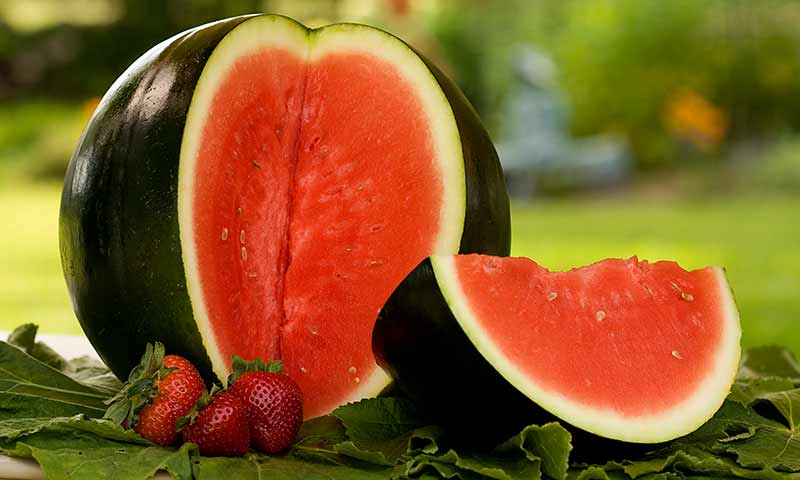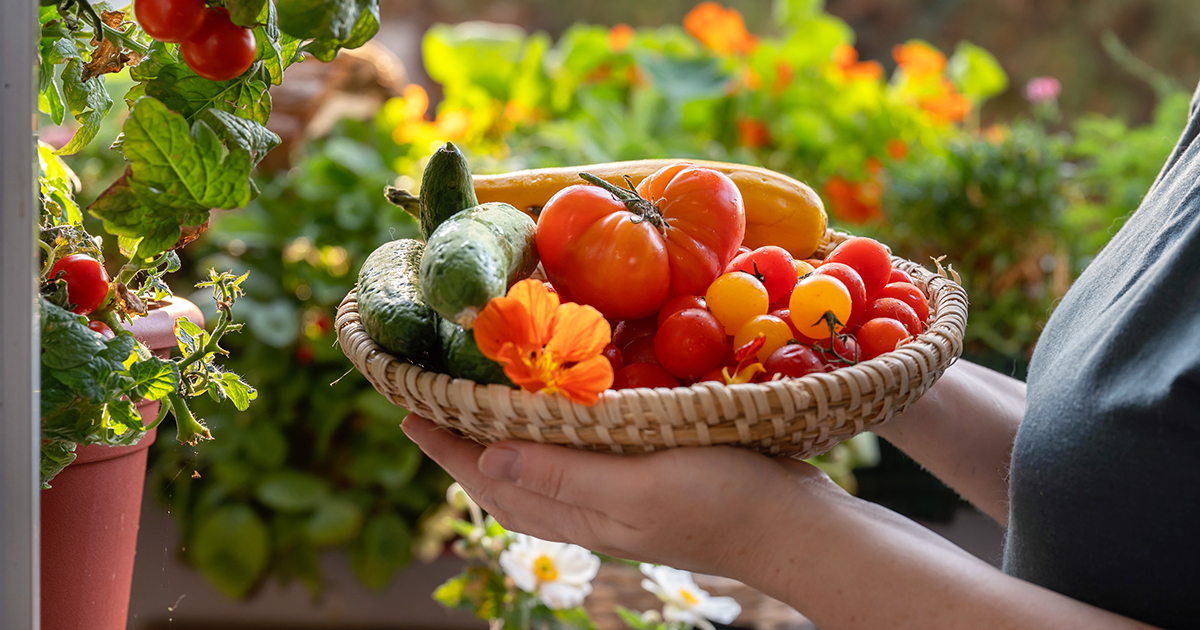How to Grow Melons
Homegrown melons are one of Mother Nature's sweetest summertime gifts. From nostalgic watermelons to cantaloupe, these garden fruits are hard to resist. Melons aren't fussy, but they do require some extra TLC to look, grow and taste their very best. When you grow your own melons, that sweet, juicy fruit is worth all the effort.
- Choosing Melon Varieties
- Planting Melons From Seed
- Caring for Homegrown Melons
- Harvesting Garden Melons

Trellised melons take up less space and keep fruit off the ground.
Choosing Melon Varieties
When choosing melons to grow in your home garden, keep three considerations in mind: the type of melon or melons you like to eat, how much space you want devoted to this crop and the length of your growing season.
Melons vary a lot in their sweetness levels, aromas and looks. If you're someone who tastes with your eyes and nose first, then color, texture and smell matter — a lot. Take time to investigate just how sweet and how different specific melon varieties can be.
As a group, melons of all kinds tend to like lots of space. Some varieties grow 20-foot vines that rival traditional pumpkins for their rambling ways. But many melon varieties exist for smaller spaces, including outdoor pots.
Honey Rock cantaloupe's heirloom vines grow just 3 to 5 feet long, ideal for a vertical trellis. Compact Sugar Baby watermelon is perfect for small gardens, with its 2- to 3-foot vines and round 10- to 12-pound fruits.
Climate also matters. Like tomatoes and hot peppers, melons are warm-season plants that can't take cold weather. Their fruit needs a long, warm growing season to fully mature. If you live in a cold climate, consider starting your seed indoors three or four weeks before your final spring frost to get a head start on summer.
Otherwise, pay close attention to how long varieties need to mature before fall frosts hit. Honey Rock cantaloupe, for example, needs 85 days from planting to harvest. Sugar Baby watermelon takes just 65 days or so — about half the time of full-size watermelons.

Feed your melons when flowering ends and fruit sets.
Planting Melons From Seed
Like most homegrown fruits and vegetables, melons need full sun to achieve their delectable potential. Choose a planting site that gets a minimum of 6 to 8 hours of full sun each day. The more sun your melons get, the more vines, flowers, fruit and sweetness you can expect. Melons depend on insects for pollination, so a pollinator-friendly wildflower garden nearby can't hurt!
Wait to plant until all danger of frost is past and your soil — not just the air — has warmed to at least 65 degrees Fahrenheit. If you don't have a soil thermometer, pick one up online or at any garden store. (They're inexpensive. You won't regret it.) If you've already prepared a vegetable garden, you're ready. If not, take time to prep your native garden soil.
Take a page from regenerative agriculture and show your soil some love. Pennington Rejuvenate Natural & Organic Garden Soil Mix revitalizes native soil and provides gentle nutrients to help feed your melons all season long. Earth-friendly ingredients like bio-stimulants, earthworm castings and sustainably sourced peat work in harmony with nature to create a living soil environment for all your plants.
If you're giving container melons a try, trust their roots to Pennington Rejuvenate Premium All Purpose Potting Soil Mix. Designed with container growing in mind, this premium potting soil mix nurtures plants with essential plant nutrients and more earth-friendly ingredients, plus water-holding crystals to help you optimize your water use.
Our organic seed packets include all the information you need for when and how to plant in your region. Most melon seeds are planted 1 inch deep in small hills, but spacing varies based on their potential size. If you're growing melons vertically — in pots or in the ground — place your trellis or other supports at planting time so they don't disrupt new roots and vines.

Sugar Baby watermelon's outer rind turns nearly black when ripe.
Caring for Homegrown Melons
As you might expect from fruit this juicy, homegrown melons and proper watering go hand in hand. Melons prefer up to 2 inches of water per week, from rainfall or irrigation. That's double many common garden veggies and fruits. It's best to water deeply and less frequently. The soil should be soaked when you're through.
This part may sound counterintuitive: The closer you get to harvest, the less water your melons need. This is especially important during the last two weeks before harvest. Cutting back on water heightens sugar content and improves flavor in the fruit. Plus, too much water during that time can cause fruit to crack and split. Take it from us: After that wait, losing even one is heartbreaking.
Always try to water the soil around your plants, not their leaves. Wet leaves encourage fungal diseases on foliage, vines and fruits. Use drip irrigation or just water carefully to keep leaves dry. Water early in the day, so any wet leaves can quick-dry in midday sun.
Feed your melons throughout the growing season with a fertilizer specifically formulated to promote fruit instead of green, leafy growth. Pennington Rejuvenate Plant Food Tomato & Vegetable 4-5-4 nurtures your soil and your melons with a blend of organic and natural ingredients, including earthworm castings, beneficial microorganisms and humic acids that help plants thrive. You'll enjoy bigger more bountiful crops than unfed plants.
Feed your melons three times: when you plant seeds, when vines begin to grow and again after vines flower and fruit starts to form. Along with all the good ingredients, Pennington Rejuvenate Plant Food Tomato & Vegetable 4-5-4 includes added calcium, which helps prevent calcium deficiencies associated with blossom end rot in melon plants.
If you trellis your melons, give developing fruits a little support. Think of it like mini melon hammocks to take the weight off your vines. Stretchy, quick-drying netting works great. If tying knots is in your skillset, a super-basic macramé-ish hanger works even better.

The season's first bite of sweet, ripe melon is worth the wait.
Harvesting Garden Melons
With all kinds of melons, be prepared to harvest fruit as soon as it's ripe. When cantaloupe is ready, it separates from the vine right at the stem in what's called "full slip." Their strong, sweet, musky aroma is another clue. Don't delay your harvest. Left on the ground, melons may rot — and the longer you wait, the less sweet they'll be.
For watermelon, knowing when to harvest is a little trickier. For ground-grown fruits, their undersides change color from greenish to yellowish. Leaves, vines and tendrils near the fruit shrivel, dry and look dead. Of course, there's always the thump test. Ripe melons have a dull, hollow sound when thumped with your knuckles. (For comparison, practice on some unripe melons early in the season.)
Melons hit their peak of sweetness when fully ripe. If you can, pick and eat them the same day. If not, refrigerate melons to eat within one or two days.
With homegrown melons, you can enjoy another successful collaboration with Mother Nature, thanks to nourishing the soil and plants in your care. At Pennington, we're here to help you nurture your roots and celebrate the abundance that comes from your slice of earth. Let us help your yard and garden dreams come true.
Always read product labels thoroughly and follow the instructions carefully.




